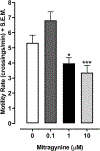Kratom pharmacology: Clues from planarians exposed to mitragynine
- PMID: 34146575
- PMCID: PMC8440406
- DOI: 10.1016/j.physbeh.2021.113499
Kratom pharmacology: Clues from planarians exposed to mitragynine
Abstract
Mitragynine (MG), the most prevalent bioactive alkaloid in kratom, displays nanomolar affinity for µ, κ and δ opioid receptors and produces opioid-dependent antinociception and dependence in rats. Here, using a battery of behavioral assays, we investigated MG effects in planarians. Acute MG exposure (< 100 μM) did not affect planarian motility or environmental preference, but reduced motility was detected during abstinence from chronic MG (1, 10 μM). MG (10 μM) produced place conditioning effects that were reduced by naltrexone (10 μΜ). These results suggest that MG produces opioid-sensitive reinforcing effects in planarians and MG pharmacology is conserved across different species.
Keywords: Dependence; Invertebrate; Kratom; Mitragynine; Opioid; Place preference; Planarian.
Copyright © 2021. Published by Elsevier Inc.
Figures



Similar articles
-
Mitragynine, bioactive alkaloid of kratom, reduces chemotherapy-induced neuropathic pain in rats through α-adrenoceptor mechanism.Drug Alcohol Depend. 2020 Apr 1;209:107946. doi: 10.1016/j.drugalcdep.2020.107946. Epub 2020 Feb 27. Drug Alcohol Depend. 2020. PMID: 32145665 Free PMC article.
-
Interactive Effects of µ-Opioid and Adrenergic-α 2 Receptor Agonists in Rats: Pharmacological Investigation of the Primary Kratom Alkaloid Mitragynine and Its Metabolite 7-Hydroxymitragynine.J Pharmacol Exp Ther. 2022 Dec;383(3):182-198. doi: 10.1124/jpet.122.001192. Epub 2022 Sep 24. J Pharmacol Exp Ther. 2022. PMID: 36153006 Free PMC article.
-
Kratom Alkaloids, Natural and Semi-Synthetic, Show Less Physical Dependence and Ameliorate Opioid Withdrawal.Cell Mol Neurobiol. 2021 Jul;41(5):1131-1143. doi: 10.1007/s10571-020-01034-7. Epub 2021 Jan 12. Cell Mol Neurobiol. 2021. PMID: 33433723 Free PMC article.
-
Pharmacokinetics of mitragynine, a major analgesic alkaloid in kratom (Mitragyna speciosa): A systematic review.Asian J Psychiatr. 2019 Jun;43:73-82. doi: 10.1016/j.ajp.2019.05.016. Epub 2019 May 9. Asian J Psychiatr. 2019. PMID: 31100603
-
Kratom (Mitragyna speciosa): worldwide issues.Curr Opin Psychiatry. 2020 Jul;33(4):312-318. doi: 10.1097/YCO.0000000000000621. Curr Opin Psychiatry. 2020. PMID: 32452943 Review.
Cited by
-
Energy drink produces aversive effects in planarians.Physiol Behav. 2022 Oct 15;255:113933. doi: 10.1016/j.physbeh.2022.113933. Epub 2022 Jul 26. Physiol Behav. 2022. PMID: 35905805 Free PMC article.
References
-
- Adams K, Byrne T. Histamine alters environmental place preference in planaria. Neurosci Lett. 2019; 705:202–205. - PubMed
-
- Anraku T, Ikegaya Y, Matsuki N, Nishiyama N. Withdrawal from chronic morphine administration causes prolonged enhancement of immobility in rat forced swimming test. Psychopharmacology. 2001; 157(2):217–20. - PubMed
-
- Behnood-Rod A, Chellian R, Wilson R, Hiranita T, Sharma A, Leon F, McCurdy CR, McMahon LR, Bruijnzeel AW. Evaluation of the rewarding effects of mitragynine and 7-hydroxymitragynine in an intracranial self-stimulation procedure in male and female rats. Drug Alcohol Depend 2020; 215:108235. - PMC - PubMed
-
- Buttarelli FR, Pellicano C, Pontieri FE. Neuropharmacology and behavior in planarians: translations to mammals. Comp Biochem Physiol C Toxicol Pharmacol. 2008; 147:399–408. - PubMed
Publication types
MeSH terms
Substances
Grants and funding
LinkOut - more resources
Full Text Sources

